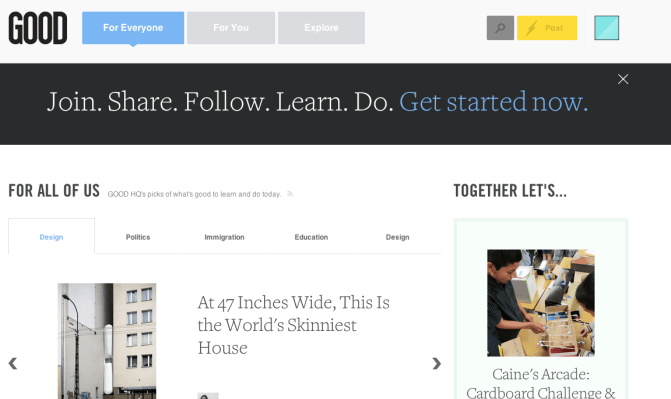Good Magazine, the publication aimed at socially-conscious consumers, has been through some ups and downs in the last year — buying social media platform Jumo (up), getting rid of editorial staff (down) and, now, pivoting the company (jury still out): today sees the official launch of a new version of Good’s site, away from that of an online magazine, and now refocused as a social media platform based around good causes and good karma.
The new Good is still in its early days: it has a nice look, with a “good” button (of course) for liking things and a pared-down interface that is reminiscent of the visual look of Pinterest. You have followers and you follow people, and you can also get access to a kind of curated firehose of content. But it’s missing some key features, for example, a full site search to find new people to follow. That, a mobile app, and much more are still to come, co-founder Ben Goldhirsh told me in an interview.
Still, it might have a more forgiving audience: early numbers show that visitors to the beta version of the new social platform are spending 50% more time on it, and racking up 50% more pageviews, than they did on the old magazine’s site, Goldhirsh said.
Good is part of the trend of social media sites that cater to specific groups of people with specific interests in mind, an attempt to make some order out of the long tail of content on the web today. (Others include Family Leaf, a kind of Facebook for families; and Menshn, a Twitter-like site for people who only want to talk politics.) At the same time, he notes that there is a lot of fragmentation in the kind of content that falls into Good’s editorial category. Some of it is pitched as lifestyle content, and there are other places to learn about charity and relief efforts, and some of it can even be classified as health and environment/science content. The idea here is that all of it is brought together.
And it will be banking on the fact that the old site of Good Magazine — still being printed on a quarterly basis — has over a million monthly visitors. Good’s business, such as it was before the pivot, was actually profitable, with revenues mainly coming from ads.
It may seem slightly random for a magazine to pivot into becoming a social media platform, but in a sense there is also a logical progression here, says Goldhirsh. If Good was about covering social causes and socially aware living, then it should be making use of other content that covers that, too — not just what it could produce itself. “If the New York Times does an awesome infographic on economic disparity, you think,’Aw, we should have done it.’ But from a mission standpoint, that’s nonsense. It shouldn’t matter whether we made it or not,” Goldhirsh said.
Equally, if part of the ethos of Good is to encourage people to engage in things, then social media, which relies on user-generated content as well as posting and cross-posting content from other places, is the very embodiment of that. It also seems that pivoting is part of the company’s DNA. Before Goldhirsh launched the magazine in 2006, Good was a film production company.
Also: Good is not totally abandoning its editorial role in the endeavor. It will be curating content on the site, featuring certain stories — including from its own magazine — on the site’s homepage and in other areas. And it will also be on the lookout for people who post things that are not kosher — that is against the ideals of community spirit and so on. Those who post spammy content, Goldhirsh tells me, will be warned; totally inappropriate content might simply be removed altogether.
Good’s social media platform hasn’t been created out of the blue, of course. In August 2011, Good acquired Jumo, a social networking site for fundraising and good causes, which was co-founded by Chris Hughes, who also helped start Facebook and later was chief digital officer of the Obama 2008 campaign. That provided some of the IP and direction for how Good developed this platform. Hughes did not come over with the acquisition but has stayed on as an advisor, says Goldhirsh.
“When Jumo merged with GOOD the hope was to build a single community of engaged citizens and mission-driven organizations. We all believed that socially minded people needed a place to convene, join forces, learn from one another and take action together – I think the new good.is can be that place,” said Hughes in a statement.
While some social media sites present themselves as the anti-Facebook in their ambitions, Good has more of a symbiotic relationship: users are given the option to sign in with Facebook to the site, which will let them share items across the two networks. But at the same time, Goldhirsh says that Good will be able to provide something to people that they cannot get on Facebook. “Facebook is all about sharing your status and your photographs. Pinterest is about sharing your aesthetics,” he said. “This is about sharing your ideas. There is a difference.”
The site’s highlighting some early members like Caterina Fake, co-founder of Flickr, Scott Harrison, founder of Charity: Water, and Hughes. But if this takes off some of the more interesting developments may be yet to come: Goldhirsh notes that it’s planning to integrate APIs to enable on-site donations and crowdfunding, and it might even incorporate some more services to better connect the users, including, believe it (or not), a dating site: “We’ve had a lot of marriages come out of Good,” he said. “Dont’ think we haven’t thought of doing this.”
